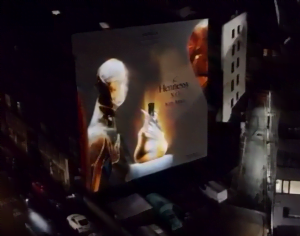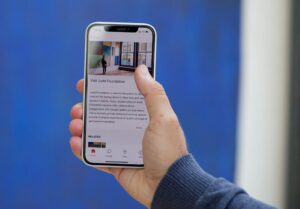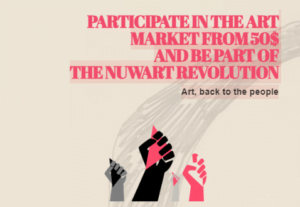The coming together of art and technology, referred to as arttech, is dynamic and constantly evolving. New innovations, and companies monetising them, are transforming art creation, the appreciation of art, and art marketplaces. This snapshot of the sector is in three sections: how technology is being used to create art; how it is being used to experience the enjoyment of art; and arttech’s impact on how it is being traded, whether for decorative purposes or as an investment. It ends with a look to the future of arttech.
Technology in art creation
Virtual and Augmented Reality
Artists are using VR and AR technology to create immersive and interactive artworks.
- VR allows viewers to step into a virtual world and experience art in new ways.
- AR integrates digital elements into the real world, often viewed through a smartphone or tablet.

Artists can overlay virtual objects or animations onto physical spaces, creating interactive and dynamic art experiences. A mainstream-media example of this in an art form in the UK was the projection of an elephant into a popular tv dance contest, which the contestants interacted with. The virtual production company responsible for it, Mo-Sys, has since established itself in Los Angeles to work with Hollywood film studios.
The dancing elephant on the tv show is an example of both AR and creating large-scale installations that invite participant or viewer interaction. Such installations often employ sensors, motion tracking, and other technologies to respond to peoples’ actions, creating dynamic and engaging experiences.
Acute Art is another London-based company, working with artists to create virtual and augmented reality artworks. The company has collaborated with artists such as Jeff Koons and Marina Abramovic to create immersive and interactive art experiences. Its app is a new way to discover, experience and collect interactive artworks in augmented reality by the world’s most celebrated artists.
Projection mapping

Rather than creating virtual stand-alone installations, projection mapping involves projecting images or videos onto often irregular surfaces, such as buildings or sculptures, to transform their appearance and create immersive visual experiences. This is increasingly used by advertisers to create spectacular one-off executions that then earn their payback by generating media coverage.
Generative AI
This refers to artificial intelligence systems that can generate content autonomously. It has democratized the creation of artwork and graphic images, providing both professional artists and amateurs with new tools and avenues for creativity.
AI training to generate the output is often based on patterns and examples provided during a process that can focus on specific art styles such as impressionism, surrealism, or cubism, and it learns to generate new artwork in that style. Artists and designers can use these generative models as a source of inspiration or to create unique pieces of art.
Through graphic images, generative AI can also create logos, illustrations, and designs. By training on large datasets of existing graphics, AI models can learn the underlying patterns and styles and generate new images that align with the desired aesthetic. This has proven to be particularly useful in creative fields where visual content needs to be generated at scale, such as advertising, branding, and digital media.
However, it is not without controversy over matters including breach of copyright of existing content used in the AI training. “Before businesses can embrace the benefits of generative AI, they need to understand the risks – and how to protect themselves,” said a Harvard Business Review article in April 2023. The most popular programs, Midjourney and DALL-E, were both trained on LAION-5B. This is a dataset of 5 billion images downloaded from the internet without their creators’ consent.
The internet as a new art medium
With the rise of the internet and digital connectivity, artists are also exploring the online space as a distinct medium for art. This includes net art, web-based art, social media art, and other forms of digital expression.
The term ‘net art’ emerged in the 1990s when it became used to describe a process of making art using a computer in some form or other, whether to download imagery that is then exhibited online, or to build programs that create the artwork. Artists soon found that the internet was a useful tool to promote their art uninhibited by political, social or cultural constraints. For this reason it came to be regarded as subversive, according to the UK’s Tate Gallery. The Tate’s description of net art sub-genres of software art, browser art and telematic art are here.
AI-generated art is a major draw on TikTok and other social platforms. Social media has been flooded with new visualizations and convincing deepfakes, posted by a new breed of tech-savvy creators, since generative AI image-making tools went mainstream in 2022.
Technology enhances art appreciation
Technological advances continue to enhance accessibility, expand the reach of artworks, and provide new ways to engage with art. By leveraging advancements in imaging, virtual reality, augmented reality and online platforms, people can experience and appreciate art in novel and immersive ways, transcending geographical limitations and physical barriers. Here are some examples.
Online experiences
High-resolution imaging technologies, such as gigapixel photography and ultra-high-definition (UHD) scanning, are the basis for many of the latest developments. It allows for detailed and zoomable views of artworks, enabling viewers to explore artworks remotely and examine them at a level of detail beyond the capabilities of the naked eye.
Whilst many original artworks are kept unseen in storage due to a lack of display space, numerous museums and art institutions have digitized their collections and made them accessible online. Users can explore these vast digital archives, view high-quality images of artworks, and access detailed information about each piece. This allows for broader access to artworks that could be physically located in different parts of the world.

Virtual tours use technologies like 360-degree cameras and virtual reality (VR) to provide immersive experiences. Viewers can navigate through virtual galleries, view artworks from different angles, and access additional information about the pieces. See the Mona Lisa on a virtual tour of the Louvre Museum in Paris from anywhere in the world.
Online platforms have emerged that are dedicated to art streaming, providing services for museums, art institutions and performance venues to stream their content online. They also allow users to access live or recorded art events, performances, and exhibitions remotely from the comfort of their homes, regardless of their geographic location. The Bloomberg Connects app provides expert-curated content and guides to over 200 museums, galleries, sculpture parks, gardens, and cultural spaces.
Art recommendation systems developed by machine learning algorithms and artificial intelligence are widening our horizons. They analyse users’ preferences and behaviours to suggest artworks, artists, or exhibitions that might align with their interests. This technology helps individuals discover new artworks and artists that they might not have encountered otherwise.
For collectors of contemporary art, principally high net worth individuals, Sedition is a digital platform enabling them to display and trade their digital art. The platform also works with leading contemporary artists such as Tracey Emin and Shepard Fairey to create limited-edition digital artworks.
Improving ‘in-person’ experiences

AR technology and mobile apps also provide interactive experiences when in the physical presence of artworks. Users can point their smartphones or tablets at specific pieces, and additional digital content such as animations, audio guides, or contextual information is overlaid on the device’s screen, enhancing the viewing experience.
To display images in the home or workplace, the Meural company produces digital smart frames that display high-quality art images. The frames use gesture controls and voice commands to enable users to change images and access information about the artworks on display.
Art technology is boosting art trading and investing
New platforms and technologies have emerged to facilitate the buying and selling of artwork, whether for personal enjoyment or as an investment. Online art marketplaces have gained popularity, providing a digital platform for artists, galleries, and collectors to showcase and sell artwork. These platforms often feature a wide range of artworks, allowing buyers to browse, purchase, and even negotiate prices directly with sellers.
Benefits of blockchain and cryptocurrency
Blockchain technology has made significant strides in the art world, primarily through the use of non-fungible tokens (NFTs). Artists can create and sell unique digital assets as NFTs, allowing for secure ownership, provenance verification, and potential royalty streams through smart contracts. This means the original artist receives a payment every time each of their works changes hands. Cryptocurrencies are also being accepted as a form of payment for artwork on some platforms, avoiding currency exchange issues and enabling swifter transactions.
NFTs can also verify part-ownership of a physical work of art, and have contributed to the trend of fractionalized ownership of tangible high value assets. This has opened a new marketplace for smaller investors who can now consider a wider portfolio of more affordable investment assets that were previously inaccessible.

Want to part-own some Andy Warhol or Banksy original art for as little as $50? Paris-based Nuwart offers investors fractionalised ownership of blue chip art. Blockchain and NFT/DAO tech mean that crowdfunding investors will retain their part-art ownership legal rights even if the platform fails.
Maecenas is a blockchain-based UK platform that enables fractional ownership of artwork. It tokenizes high-value artworks as “Art Shares” using blockchain technology, allowing investors to buy and trade shares in original artwork. Maecenas provides a transparent and secure platform for investing in art.
Non-NFT fractionalized ownership
Here are three examples of how fractionalized art ownership can be managed without NFTs by using other tech.
- Masterworks is a U.S. investment platform based in New York that allows users to invest in shares of artwork. It acquires blue-chip artworks and offers shares to investors, which they can trade on the Masterworks platform. Masterworks also has a sales team that deals with the top collectors in the art market. If they sell an artwork, the new value is represented in the share values, earning returns for the shareholders.
- Arthena, also based in New York, is an investment platform that uses machine learning to invest in art assets. It creates portfolios of fine art, and offers diversified art funds in which investors can own shares. Arthena’s technology continually monitors data from art sales, can track the work of individual artists, and its valuation service advises clients on the optimum times to buy or sell based on their personalized art investment profile.
- Konvi offers fractionalized ownership of art alongside prestigious watches, fine wines and whiskies, and other luxury items including cars. Ring-fenced holding companies are created to individually own each asset, and investors buy shares in the companies of their choice. Assets are sold at the end of pre-set appreciation periods, ranging from 2 to 10 years, and the profits are shared between the shareholders and the platform.
Online Auctions
Traditional auction houses have established online platforms that allow for remote bidding and buying. These platforms provide access to a global audience, enabling collectors to participate in auctions from anywhere in the world. The technology that drives decentralized finance is transforming the auction industry with transparency, security, and wider accessibility. With blockchain and smart contracts, DeFi allows anyone to initiate or participate in auctions in a permissionless and trustless manner. Here are some potential ways that blockchain could impact on art auctions.
Increased transparency and provenance: one of the most significant potential benefits of blockchain technology in the art world is its ability to provide a secure and transparent ledger for tracking the provenance of artworks. By using blockchain technology to record the ownership history of an artwork, auction houses can increase transparency and provide buyers with greater confidence in the authenticity of the artwork.
Reduced fraud: by using blockchain technology to record transactions, auction houses can reduce the risk of fraud and ensure that transactions are secure and tamper-proof. This could be particularly valuable in the art world, where cases of fraud and forgery are not uncommon.
Improved efficiency: blockchain technology can potentially streamline the auction process by automating many of the steps involved in buying and selling artworks, such as recording ownership changes, tracking payments, and verifying authenticity. This could help reduce the administrative burden on auction houses and enable them to operate more efficiently.
Virtual Exhibitions and Art Fairs
The arttech that powers virtual art fairs and exhibitions means artists and galleries can showcase and even sell their artworks. Visitors can explore virtual booths, interact with artworks, and sometimes make purchases.
Social Media and Influencer Marketing
Social media platforms have become powerful tools for artists to promote and sell their artwork. Artists can leverage platforms like Instagram, Twitter, and TikTok to reach a broad audience, showcase their portfolio, engage with followers, and drive sales. Influencer marketing has also gained traction in the art world, with artists collaborating with social media influencers to promote their artwork to their followers.
What is the future of ArtTech?
The future of arttech (art and technology) is likely to be shaped by continued advances in technology and its integration into various aspects of artistic practice. Here are some potential trends and developments that may shape the future of arttech.
Virtual and augmented reality (VR/AR) technology is likely to become more prevalent in art exhibitions, installations, and performances, offering audiences immersive and interactive experiences.
Artificial intelligence (AI) is already being used in some artistic practices, such as generating music and visual art. As AI technology improves, we may see more artists using it to create new works and explore new creative avenues.
Blockchain technology is increasingly being used in the art world to authenticate and track artworks, and this trend is likely to continue. We may also see the emergence of new art marketplaces and platforms based on blockchain technology.
3D printing and other digital fabrication technologies are becoming more accessible and affordable, enabling artists to create physical objects with greater precision and complexity.
Collaborations between artists and technologists are likely to increase, leading to the creation of new forms of art and the development of new technologies that can be used in creative practice.
Overall, the future of arttech is likely to be characterized by a blurring of the boundaries between art and technology, as artists continue to explore creative possibilities.
The 5th edition of BOLD Awards includes an ArtTech category for the first time. The category celebrates pioneering advancements at the intersection of art and technology. Recognizing the transformative power of technology in the art world, this award honors innovative initiatives, projects, or products that push boundaries and redefine artistic expression with technology. Entries can be submitted now.






